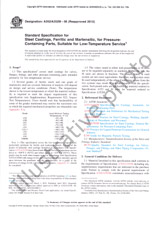We need your consent to use the individual data so that you can see information about your interests, among other things. Click "OK" to give your consent.
ASTM D6641/D6641M-16e2
Standard Test Method for Compressive Properties of Polymer Matrix Composite Materials Using a Combined Loading Compression (CLC) Test Fixture (Includes all amendments And changes 12/6/2023).
Translate name
STANDARD published on 1.11.2016
The information about the standard:
Designation standards: ASTM D6641/D6641M-16e2
Note: WITHDRAWN
Publication date standards: 1.11.2016
SKU: NS-1020823
The number of pages: 13
Approximate weight : 39 g (0.09 lbs)
Country: American technical standard
Category: Technical standards ASTM
The category - similar standards:
Annotation of standard text ASTM D6641/D6641M-16e2 :
Keywords:
combined loading, composite materials, compressive modulus of elasticity, compressive properties, compressive strength, Poisson´s ratio,, ICS Number Code 83.140.10 (Films and sheets)
Additional information
| Significance and Use | ||||||||||||||||||||||||||||||||||||||
|
5.1 This test method is designed to produce compressive property data for material specifications, research and development, quality assurance, and structural design and analysis. When tabbed (Procedure B) specimens, typically unidirectional composites, are tested, the CLC test method (combined shear end loading) has similarities to Test Methods D3410/D3410M (shear loading) and D695 (end loading). When testing lower strength materials such that untabbed CLC specimens can be used (Procedure A), the benefits of combined loading become particularly prominent. It may not be possible to successfully test untabbed specimens of these same materials using either of the other two methods. When specific laminates are tested (primarily of the [90/0]5.1.1 Ultimate compressive strength, 5.1.2 Ultimate compressive strain, 5.1.3 Compressive (linear or chord) modulus of elasticity, and 5.1.4 Poisson's ratio in compression. |
||||||||||||||||||||||||||||||||||||||
| 1. Scope | ||||||||||||||||||||||||||||||||||||||
|
1.1 This test method determines the compressive strength and stiffness properties of polymer matrix composite materials using a combined loading compression (CLC) 1.2 The compressive force is introduced into the specimen by combined end- and shear-loading. In comparison, Test Method D3410/D3410M is a pure shear-loading compression test method and Test Method D695 is a pure end-loading test method. 1.3 Unidirectional (0° ply orientation) composites as well as multi-directional composite laminates, fabric composites, chopped fiber composites, and similar materials can be tested. 1.4 The values stated in either SI units or inch-pound units are to be regarded separately as standard. Within the test the inch-pound units are shown in brackets. The values stated in each system are not exact equivalents; therefore, each system must be used independently of the other. Combining values from the two systems may result in nonconformance with the standard. Note 1: Additional procedures for determining the compressive
properties of polymer matrix composites may be found in Test
Methods D3410/D3410M,
D5467/D5467M, and
D695.
1.5 This standard does not purport to address all of the safety concerns, if any, associated with its use. It is the responsibility of the user of this standard to establish appropriate safety and health practices and determine the applicability of regulatory limitations prior to use. |
||||||||||||||||||||||||||||||||||||||
| 2. Referenced Documents | ||||||||||||||||||||||||||||||||||||||
|
We recommend:
Technical standards updating
Do you want to make sure you use only the valid technical standards?
We can offer you a solution which will provide you a monthly overview concerning the updating of standards which you use.
Would you like to know more? Look at this page.




 Cookies
Cookies
